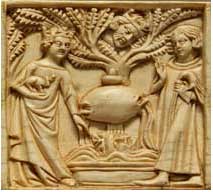
Tristan and Isolde, in a German woodcut (1400s AD)
In the story, Isolde was a princess in Ireland, and a great healer. She was the best doctor in the land. One day this guy Tristan shows up. He’s been sent by his uncle King Mark to get Isolde and bring her back for King Mark to marry. At first Isolde doesn’t want to go. But Tristan convinces Isolde that he’s cool, and she agrees to sail to England with him.
Isolde doesn’t know that she’s got a magic love potion hidden in her stuff. Her maid is supposed to give the drink to King Mark when she gets there, to make sure King Mark falls in love with Isolde. But on the boat, Isolde accidentally finds the love potion. She and Tristan mistakenly drink it – and so they fall in love with each other, instead.

Tristan and Isolde, and the king spying on them from the tree (French ivory carving, 1200s AD)
When Tristan and Isolde arrive in England, she marries King Mark anyway. But the potion forces her to keep seeing Tristan on the side. Eventually people begin to suspect. King Mark catches them and is very angry. In one version, he sneaks up on Tristan and pierces him with a poisoned spear while Tristan is playing the harp for Isolde. Isolde begs Tristan to crush her to death in his arms so they can die together, and he does.
In the other ending of the story, King Mark keeps Isolde and exiles Tristan across the English Channel to Brittany (in France). In Brittany, he marries another girl just because her name is also Isolde. Many years later, Tristan tries to rescue a young woman from six knights who are attacking her, and he gets pierced by a poisoned spear. Only Isolde’s great healing skills can save him, so he sends for her, and she comes. But his jealous wife Isolde tells him that his lover Isolde refuses to come, and Tristan dies in despair.
In some ways, this story is a lot like the story of Lancelot and Guenevere. It’s also like an earlier Irish story of Diarmuid and Grainne, and a little like the Persian story of Vis and Ramin. These are all Indo-European stories, and the original stories probably go back to before the Indo-Europeans left Central Asia.
Lancelot and Guinevere
Bibliography and further reading about King Arthur and the Knights of the Round Table:




